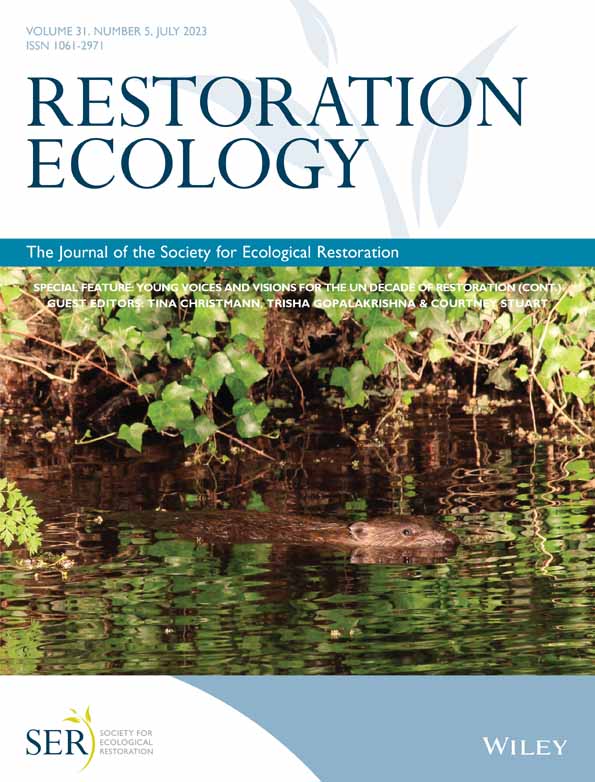No detrimental effects of soil disturbance resulting from grassland restoration operations on aboveground-dwelling invertebrate communities
Author contributions: DS, RaA, JYH conceived and designed the research; DS, CA, EFC, YK, RR, LR, GE, JYH performed the experiments; CA, EFC, RoA, MS, IH, DS identified the invertebrates to species level; JYH, CA, EFC, DS, RoA analyzed the data; DS, CA, EFC, RoA, MS, IH, RaA, JYH wrote and edited the manuscript.
Abstract
Active grassland restoration requires soil disturbance by harrowing or plowing prior to seeding to create favorable conditions for plant germination. Yet, it is still unknown if these soil interventions are detrimental to the local ground-dwelling invertebrate fauna. We evaluated how ground beetle (Carabidae) and spider (Araneae) communities, two important grassland bioindicators, respond to three common grassland restoration methods, differing in soil disturbance intensity and seed application method. The study was carried out in 47 extensively managed mesic meadows using a before-after-control-intervention design. It was applied at the field scale and replicated 12 times across selected Swiss lowland sites. We did not detect any significant differences in abundance and species richness of ground beetles and spiders between restored and control meadows 1 year after restoration. At the community level we observed a slight shift towards a preference for wetter habitat (for both invertebrate groups), and restored meadows harbored a smaller weighted mean body size of spiders than control meadows. The latter was mainly driven by a higher abundance of some small pioneer species typically found in frequently disturbed habitats, notably in arable fields. Our results suggest that 1 year after restoration action, the ground-beetle and spider communities recovered almost entirely to their predisturbance state, indicating that, with respect to above ground-dwelling invertebrates, harrowing or plowing can be applied when restoring plant species-poor grasslands.
Implications for Practice
- So far only few studies focused on potential damaging effects of grassland restoration measures on resident invertebrates.
- Ground beetle and ground-dwelling spider communities recovered 1 year after the soil disturbance (harrowing and plowing) used to support mesic grassland restoration operations.
- These soil disturbance interventions can be performed with little risk of detrimental effects on the existing local ground beetle and ground-dwelling spider communities, and we assume that the same applies to other epigeal invertebrates.
Introduction
Temperate grassland ecosystems are recognized as high nature value habitats (Veen et al. 2009) for many plants (Wilson et al. 2012), invertebrates (Batáry et al. 2007; Woodcock et al. 2012), and vertebrates (Batáry et al. 2006). In Central Europe, most temperate grasslands are semi-natural, meaning that they require regular cutting or grazing to avoid vegetation succession, and as such play an important role in feeding livestock (Hejcman et al. 2013). After World War II, and especially during the 1960s–1980s, EU grasslands have been increasingly fertilized and reseeded with low-diversity standardized commercial mixtures to achieve higher forage yield (Robinson & Sutherland 2002). This intensification has contributed to the dramatic biodiversity decline and biotic homogenization across many farmland plant and animal taxa (Kleijn et al. 2009; Gossner et al. 2016). To counteract the negative impact of high intensity agriculture on farmland biodiversity, agri-environment schemes were introduced in the 1990s in Europe. These schemes support financially a reduction of the intensity of farming practices (e.g., through lower fertilizer input), but have so far led to only limited success regarding grassland biodiversity (Pe'er et al. 2014; Batáry et al. 2015). Thus, a more proactive approach is necessary to tackle the current biodiversity crisis, in line with the objectives of the United Nations Decade on Ecosystem Restoration 2021–2030 (UNEP 2022).
Active grassland restoration, that is, the improvement of an existing, species-poor grassland through reintroduction of plant species, is often necessary in areas with a long history of intensive agriculture. This is due to the low availability of propagules in the soil seed bank and few remnant species-rich grasslands in the surrounding landscape (Bakker et al. 1996). To increase germination success within grassland restoration operations, mechanical soil disturbance is necessary prior to seeding. This disturbance is required to open the grass sward in order to reduce outcompetition from the existing plant community and to create optimal germination conditions (Schmiede et al. 2012; Freitag et al. 2021). Although grassland restoration has gained in importance in practice and research (Török et al. 2021), until now the majority of grassland restoration studies have focused on the effects upon the plant community (Kiehl et al. 2010; Slodowicz et al. 2022). The few studies dealing with invertebrates focused on their recolonization after restoration (Woodcock et al. 2010a; Déri et al. 2011; DiCarlo & DeBano 2019). Nowadays it is still unknown if the mechanical soil disturbance inherent to grassland restoration operations has an impact on the extant ground-dwelling invertebrate community. This is particularly important nowadays that we realize the magnitude of invertebrate declines (Seibold et al. 2019; van Klink et al. 2020).
Our main objective was to find out whether different intensities of soil disturbances linked to grassland restoration have a detrimental effect on the ground-dwelling invertebrate community. For our study, ground beetles (Carabidae) and spiders (Araneae) were selected to represent the epigeal invertebrate community. Both groups have proven to be valuable bioindicators to monitor the effects of ecological disturbances and the success of restoration operations (Koivula 2011; DiCarlo & DeBano 2019). Furthermore, these organisms provide important ecosystem services, such as natural pest control agents feeding on a wide variety of prey and as food sources of higher trophic levels such as birds and reptiles (Luff 1987; Lövei & Sunderland 1996; Nyffeler & Sunderland 2003). Previous studies have shown that intensive soil interventions can cause both direct and indirect mortality of these ground-dwelling organisms (Thorbek & Bilde 2004). From the viewpoint of community traits, shifts in body size and trophic level have been observed after soil disturbances (Hanson et al. 2016; Kosewska et al. 2018). A shift in the community body size of spiders may also have an indirect effect on the community mobility, since small-sized spider species tend to use aerial dispersion (ballooning) more frequently than large-sized spiders (Thomas et al. 2003). Similarly, small-sized ground-beetles are usually winged and tend to be good dispersers and are often found in higher numbers after disturbances (Luff 1987).
To address these questions, we launched a field-scale restoration experiment at 12 selected Swiss lowland sites in 2018, applying three different restoration treatments and using a nearby unrestored site as a control. While direct mortality due to harrowing or plowing has been observed for ground-dwelling invertebrates in the short-term (i.e., within few weeks after the disturbance event) in arable land (Thorbek & Bilde 2004; Shearin et al. 2007), recolonization from the surrounding landscape may occur within days after disturbance, due to the high mobility of these invertebrates (Pfingstmann et al. 2020). We predicted no differences in ground beetles and ground-dwelling spider species richness and abundance 1 year after restoration, irrespective of the soil disturbance intensity. However, we expected to still find a higher abundance of pioneer species in restored grasslands compared to unrestored control grasslands (Rushton et al. 1989). We further expected to detect some shift in the habitat preferences of both ground beetle and spider communities, given that grassland habitat conditions are altered due to changes in the habitat structure following the introduction of new plant species (Woodcock et al. 2008; Albert et al. 2019), but we were unable to predict the direction of this shift. Finally, we expected no changes in the community heterogeneity (beta-diversity). Note that most of the above-mentioned effects on the ground-dwelling invertebrate assemblages were studied in arable sites, where soil disturbances occur frequently, notably due to plowing. In contrast, soil disturbance in our restoration operations occurred only once. We thus envisioned that the invertebrate community may mostly recover within 1 year.
Methods
Study Sites and Experimental Design
We selected 12 study sites in the lowlands of the Swiss Plateau, within an altitudinal range of 420–760 m (lat 46°23′09″N–47°12′38″N, long 6°09′48″E–7°54′50″E, Fig. 1). This region is dominated by an Atlantic climate with a mean annual temperature ranging from 13.7 to 16.3°C, and an annual precipitation of 845–1,148 mm. High-intensity agriculture accounts for ca. 65% of the landscape, which is representative of Central Europe (Zingg et al. 2019). For our experiment, we selected four extensively managed mesic hay meadows per study site, which makes a total of 48 meadows. These meadows were relatively species-poor, harboring 24.6 ± 4.8 vascular plant species per 16 m2 (specifically within two 2 × 4 m plots distant by 8 m) and belonged to the class of mesic hay meadows from low and medium altitudes (Arrhenatheretalia elatioris) which are dominated by Arrhenaterum elatius, Anthriscus sylvestris, Bromus hordeaceus, Crepis biennis, and Poa trivialis (Delarze et al. 2008; Hejcman et al. 2013). All meadows were registered as biodiversity promotion areas (a Swiss equivalent to European agri-environment schemes), which implies no fertilization, no use of pesticides and a first cut not before 15 June. Selected meadows had been managed extensively for at least 5 years. All meadows had another semi-natural grassland in close vicinity (<50 m away from meadow edge). These open habitats accounted on average for 50% of the surrounding area. The minimum distance between two experimental meadows was 330 m within a study site, the maximum distance 3 km. One species-rich donor meadow was selected per study site, which served as a seed source for restoration (with 34.5 ± 6.0 vascular plant species within two 2 × 4 m plots distant by 8 m per meadow and 49.4 ± 5.4 vascular plant species per meadow over the whole meadow).
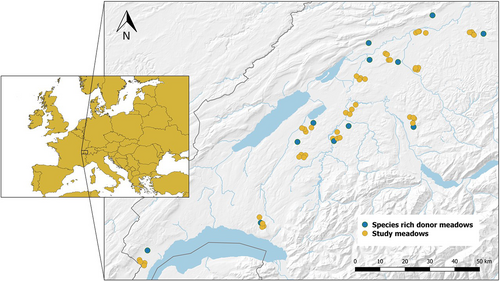
Restoration operations took place in May and June 2019. A randomized block design was adopted, where three different restoration treatments plus one unrestored control were randomly assigned to the four meadows within each study site, the latter representing the blocks (treatment names and abbreviations are summarized in Table 1). Restoration occurred at field-scale, that is, one restoration treatment was assigned to a meadow, which represents the real scale at which such operations should take place in practice (Fig. S1). The restored area on each meadow covered on average 0.5 ha, ranging from 0.14 to 1.0 ha. The harrowed treatment (hereafter HH) represented the lowest soil disturbance intensity among all three treatments. HH meadows were harrowed with a rotary harrow 1 week before seeding and were harrowed again on the day of seeding. The two plow treatments HP (Fig. 2) and SN had the strongest soil disturbance intensity. Three months before seeding, these meadows were plowed below 20 cm of depth and then harrowed a few times, roughly every 4–6 weeks, until seeding, this in order to inhibit the establishment of undesired weeds. Seeding material was applied either in form of hay (HP and HH treatments) or seeds (SN treatment). All restoration methods complied with the guidelines proposed by the Swiss Association for the Development of Agriculture and Rural Areas (AGRIDEA; Staub et al. 2015). One restoration with the SN method failed due to heavy rainfalls shortly after seeding, which left us 47 restored meadows in total.
| Control (C) | Hay harrow (HH) | Hay plow (HP) | Seeds natural (SN) | |
|---|---|---|---|---|
| Seeding material | None | Hay | Hay | Seeds |
| Soil disturbance intensity | None | Low (Rotary harrow) | High (plow) | High (plow) |
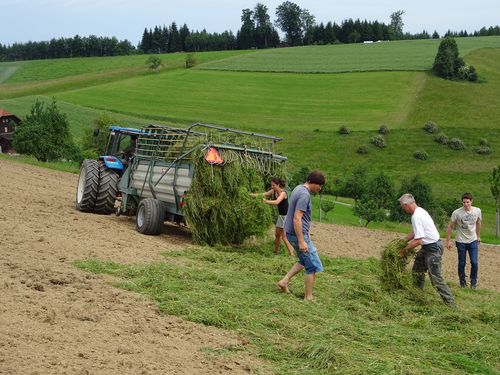
Invertebrate Sampling
Our experiment followed the before-after-control-intervention (BACI) framework. All meadows were sampled in 2018, that is, 1 year before restoration, and again in 2020, that is, 1 year after restoration.
We used pitfall traps to assess invertebrate communities during four sampling sessions of 1 week each. The first two sampling sessions were carried out between mid-May and mid-June, before the first cut of the meadows. The second two sessions were carried out shortly after the first cut, that is, from July onwards. Four pitfalls were buried in the corners of a 10 × 10 m square randomly placed in the meadow and situated at least >10 m from the meadow boundary to avoid edge effects (van Klink et al. 2019). To prevent micromammals from being trapped, the pitfalls were directly covered with a metal grid with a mesh size of 2.2 cm. To avoid trap overflowing in case of rain, the pitfalls were covered with a transparent plastic shield anchored in the ground 5 cm above the trap by three long vertical nails. To kill and preserve the invertebrates the traps were filled with propylene glycol diluted with water at a ratio of 2:1. In addition, a pinch of odor-free detergent (sodium dodecyl sulphate) was added to reduce the surface tension and allow trapped specimen to drown. From a total of 1,504 traps from both sampling years, we had to discard 47 traps due to the capture of micromammals despite the grid or because the pitfalls had been dug out. Samples were brought to the lab and the abundance of all individuals belonging to the two selected taxonomic groups was recorded per trap. Then we identified adult specimens of ground beetles and spiders to species level from one out of four traps per sampling session, that is, four traps per meadow and year, for a total of 380 pitfall traps (1 trap × 4 sessions × 47 meadows × 2 years). We followed the nomenclature of Müller-Motzfeld (2004), Nentwig et al. (2020) and Trautner and Geigenmüller (1987). Conservation statuses of ground beetles were referenced following the available Swiss Red List (Duelli 1994). At the time of the study, no Red List was available for spiders in Switzerland.
Statistical Analyses
Abundance and Species Richness
For all analyses based on the abundance of ground beetles and spiders we pooled the abundance data from all four sampling sessions by taking the mean abundance per pitfall trap per meadow and year. We used mean abundance per pitfall trap instead of the sum because of the slightly unequal number of traps per meadow per year (a few traps were unintentionally lost, see “Invertebrate Sampling” section). Species richness for ground beetles and spiders was pooled per meadow and year using the data of all identified individuals from the two taxonomic groups of reference (always based on four pitfall traps per meadow and year). This resulted in 47 mean abundance and total species richness values per year for all meadows for ground beetles and spiders.
To account for any potential year effect, we calculated the differences between the years 2020 and 2018 for both abundance and species richness per meadow. We then tested if the difference in abundance or species richness of a restoration treatment was different from the difference observed in the control. We fitted univariate linear mixed-effects models (LMMs) using the lme4 package (Bates et al. 2015) with restoration treatment as explanatory variable using restricted maximum likelihood and study site as random intercept effect. As response variables the differences between 2020 and 2018 in abundance or species richness of ground beetles or spiders were used.
Traits and Community
| Trait | Ground beetles | Spiders |
|---|---|---|
| Body size | Continuous, in mm | Continuous, in mm |
| Habitat preference | Categorical 1 = xerophilous 2 = mesophilic 3 = hygrophilous |
Continuous, from 0 (moist) to 1 (dry) |
| Trophic level | Categorical 1 = herbivore 2 = predator |
NA |
| Hibernation index | Categorical 1 = overwintering as larvae only 2 = overwintering either as larvae or as adults 3 = overwintering as adults only |
NA |
| Mobility | NA | Categorical The frequency of a species to use ballooning: 1 = rare 2 = occasional 3 = frequent |
Furthermore, multivariate analyses were performed to assess how ground beetle and spider communities were affected by the restoration treatments. We conducted these analyses separately for ground beetles and spiders for the years 2018 (before restoration) and 2020 (1 year after restoration). First, permutational tests for homogeneity of multivariate dispersions (PERMDISP) with Tukey honest significant differences (TukeyHSD) were conducted for change of heterogeneity between treatments as a measure of β-diversity (Anderson et al. 2006). Second, permutational multivariate analysis of variance (PERMANOVA) was used with 9,999 permutations and significant community shifts were assessed with a Bray–Curtis similarity based permutational test for homogeneity of multivariate dispersion (BETADISPER). All PERMANOVA outcomes were plotted on the first two principal coordinate analysis (PCoA) axes. We used the vegan package (Oksanen et al. 2020) for the multivariate analyses.
Models always fulfilled model assumptions, notably residuals normal distribution and homoscedasticity. All analyses were performed with the statistical software R version 4.1.1 (R Core Team 2021).
Results
In 2018, we collected a total of 12,258 ground beetles and 25,179 spiders. In 2020, that is, 1 year after restoration actions, we collected 12,402 ground beetles and 21,513 spiders. We identified 70 species of ground beetles being represented by 6,465 specimens (3,070 ground beetles in 2018 and 3,395 in 2020, respectively). For spiders, we identified 68 species represented by 11,394 specimens (6,243 spiders in 2018 and 5,151 in 2020, respectively). The most abundant ground beetle species was Amara fulvipes with 1,516 individuals (23% of the whole community). The most abundant spider species was Pardosa palustris with 5,564 individuals (49% of the whole community). Among the identified ground beetles, seven species were red listed. Among these, five species were very low abundant with ≤10 individuals. The two remaining red listed species, Amara kulti and Anisodactylus nemorivagus, were present across all treatments before and after restoration (Table S1). A full species list with their respective abundances is provided in the Supporting Information (Tables S4 & S5).
Abundance and Species Richness
We did not observe any difference in abundance for ground beetles and spiders for any restoration treatment compared to the control (Tables S2 & S3; Fig. 3A & 3C). Ground beetle species richness was not affected by any restoration method (Table S2; Fig. 3B). We found that spider species richness was higher in the HH treatment (compared to control; p = 0.038, Table S4; Fig. 3D). These outcomes did not change after re-running the same analyses without the most abundant species (Amara fulvipes for ground beetles or Pardosa palustris for spiders).
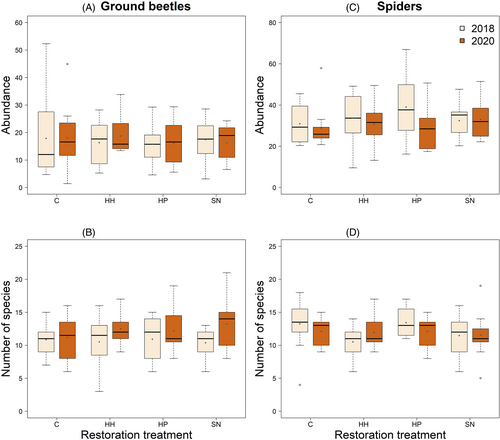
Traits and Community
For ground beetles, no restoration method showed an effect on the community traits body size, hibernation index and trophic level. The habitat preference index of ground beetles became slightly higher in the SN treatment compared to the control, indicating that the ground-beetle community became more characteristic of a wetter habitat (p = 0.009, Table S2). For spiders, all restoration methods had a negative effect on the community weighted mean body size (C vs. HH: p = 0.015, C vs. HP: p = 0.009, C vs. SN: p = 0.013, Table S3; Fig. 4A), that is, the body size of all spiders in the community became on average 0.7 mm smaller than before restoration. We noticed that two small spider species, Erigone dentipalpis and Oedothorax apicatus, increased in abundance in all restoration treatments after restoration (Figs. 4B & S5). The habitat preference index for spiders was slightly lower in the treatments HP and SN compared to the control, indicating that the spider community became more characteristic of a wetter habitat after restoration (C vs. HP: p = 0.040, C vs. SN: p = 0.023, Table S3). The mobility index was higher for the HP treatment only compared to the control, indicating more frequent ballooning (p = 0.008, Table S3).
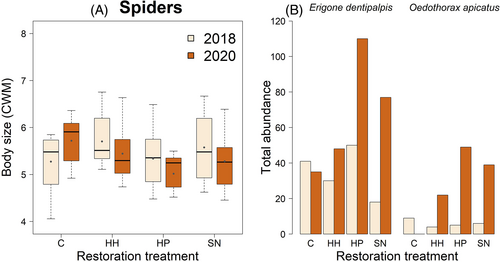
Our PERMDISP revealed that the heterogeneity of both ground beetle and spider communities was not significantly affected by any restoration treatment (Figs. 5 & S6). Similarly, the PERMANOVA showed a consistent overlap and sizing of the polygons between all treatments and years for both ground beetle and spider communities (Fig. 5). Before restoration, there was no difference in community identity between the treatments for both ground beetles (F = 0.707, p = 0.817) and spiders (F = 0.760, p = 0.775). However, we observed a significant shift in community identity for both ground beetles (F = 1.867, p < 0.001) and spiders (F = 1.366, p = 0.045) after restoration.
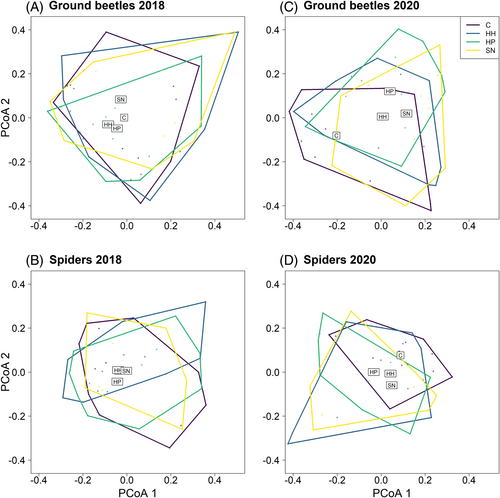
Discussion
Active grassland restoration through seed addition combined with soil preparation has been shown to be an effective tool to enhance the plant community (Kiehl et al. 2010; Slodowicz et al. 2022). However, little is known on the effect of such restoration methods on the established ground-dwelling invertebrate community. In our multi-site, real-scale experiment we found no evidence of a negative impact of any restoration method involving soil preparation by harrowing or plowing on ground beetle and ground-dwelling spider species richness and abundance in mesic meadows. Yet, we did observe some minor trait shifts respective to invertebrate communities, which were mainly due to relative changes in species abundances. The novelty of our study resides in its focus on potential negative side effects upon the invertebrate community which may be caused by soil disturbance during grassland restoration operations. Furthermore, our experimental approach using a fully randomized block design minimizes any biases due to possible confounding factors such as the surrounding landscape. Our results suggest that the ground-dwelling invertebrate community has recovered 1 year after disturbance by both harrowing or plowing. This means that there are definitely no conflicts between enhancing plant diversity of a grassland and preserving the extant resident invertebrate community (Bell et al. 2001).
Except for a small increase in spider species richness in the harrowed treatment, species richness and abundance of both ground beetles and spiders remained stable before and 1 year after restoration, as well as in comparison to the control meadows. This is well in line with our first prediction. It is known that soil disturbance such as plowing immediately induces a high mortality among soil-dwelling invertebrates, up to 60% of population size (Thorbek & Bilde 2004). However, and despite this high mortality, we assumed that grassland invertebrate communities would recover relatively quickly probably due to rapid recolonization from the surrounding landscape, which can happen as fast as within a few days (Pfingstmann et al. 2020). A similar mortality rate with subsequent recovery was also observed after mowing events (Humbert et al. 2010). Several studies have highlighted the importance of connectivity between habitats in the landscape for the recolonization of invertebrates (Woodcock et al. 2010b; Knop et al. 2011). Indeed, study meadows were usually adjacent or in close vicinity (<50 m away from meadow edge) from another permanent grassland habitat, which makes the connection of an intact invertebrate source population to our restored meadows very likely. In addition, the Swiss agricultural landscape is dominated by semi-natural grasslands (58% of utilized agricultural area, of which 23% are extensively managed, Swiss Federal Office of Statistics 2022). Further studies would be necessary to confirm the transferability of our findings to other types of agricultural landscapes, for instance those largely dominated by arable land (Tscharntke et al. 2005).
Minor shifts in the community traits confirmed our expectation, that is, that some community changes would be visible on the community trait level but not on the abundance and species richness level. Results showed that the community weighted mean body size decreased for spiders within all restored meadows. At the same time, we observed an increase in number of two small sized spider species Erigone dentipalpis and Oeodothorax apicatus from the Linyphiid family, which are often found in disturbed habitat such as arable land (Rushton et al. 1989). The higher occurrence of these two small spider species could also be an explanation for the increase in mean spider mobility, that is, ballooning frequency, in the hay plow (HP) treatment, where we observed the highest abundances in both species. Small spiders from the Linyphiid family are known to be good aerial dispersers (Bell et al. 2005). Given that both species are pioneer species, we expect their number to decrease in the coming years, when the plant assemblage will be fully established, which will reduce habitat openness (Albert et al. 2019). For both ground beetle and spider communities, we noted a slight increase in humidity preference in the plowed treatments, indicating a wetter habitat after restoration. A similar trait shift of spiders towards wetter habitats has also been observed 1 year after soil disturbance in xeric grasslands (Hamřík & Košulič 2021). Given that in the context of restoration of degraded grasslands, soil disturbance occurs only once at the onset, just prior to seed addition, we assume that, in the years to come, the habitat preference indices will return towards values found in the undisturbed control meadows. Our multivariate analyses on the community level further corroborate what we have found at the trait level. The community heterogeneity was not affected, while community composition changed. This change in community composition was mainly driven by relative changes in abundance of some pioneer species, as shown above. However, no distinct trend was visible for any of the treatments.
Finally, we could not find evidence that rare or threatened ground beetles (there is no red list for spiders in Switzerland) were affected differently. Based on the available list, we identified some low abundant, rare species before and after restoration. Due to their low number (less than 10 individuals over the entire study period) it was not possible to conclude how they responded to treatments. One ground-beetle species, Amara kulti, categorized as nearly threatened, had its abundance increasing after restoration.
In conclusion, our results suggest that a single soil disturbance event has no detrimental effects on the local grassland ground beetle and ground-dwelling spider community after 1 year. Three commonly used grassland restoration methods (Kiehl et al. 2010), differing in soil disturbance intensity, were investigated. Knowing that these restoration methods do not damage the existing epigeal invertebrate community is reassuring. Based on our results and extant restoration guidelines (e.g., Scotton et al. 2012), there is no objection to perform soil preparation prior to add seed to a meadow undergoing active restoration while being concerned about the integrity of the local above ground-dwelling invertebrate communities.
Although our study focused on the potential impact of soil disturbance on resident invertebrates, we can expect that in the long-run new species will immigrate from the surrounding landscape into the restored meadows (WallisDeVries & Ens 2010; Woodcock et al. 2012; DiCarlo & DeBano 2019). There is also evidence that hay transfer can translocate invertebrates from one meadow to another and therefore accelerate the colonization process (Kiehl & Wagner 2006; Stöckli et al. 2021). In spite of our results, it remains to be experimentally established to what extent other epigeal grassland taxa such as land snails or plant-dwelling invertebrates are affected by these restoration measures. Further studies are needed to confirm these findings for other species groups, such as soil inhabiting organisms. The first years after grassland restoration are characterized by a changing plant community, which usually stabilizes 4 years after restoration (Albert et al. 2019; Freitag et al. 2021). Yet, vegetation-dwelling invertebrates are more affected by changes in the plant community than ground-dwelling invertebrates and might therefore show a different response to the restoration treatments (Ebeling et al. 2018; Hamřík & Košulič 2021).
Acknowledgments
We acknowledge the financial support of the Swiss National Science Foundation (SNF grant to RA: 31003A_172953), the Federal Offices for the Environment and for Agriculture. We thank Werner Marggi for the ground beetle identification and verification and Andrew Francis Brown for comments on an earlier version of the manuscript. All authors declare that there is no conflict of interest.



